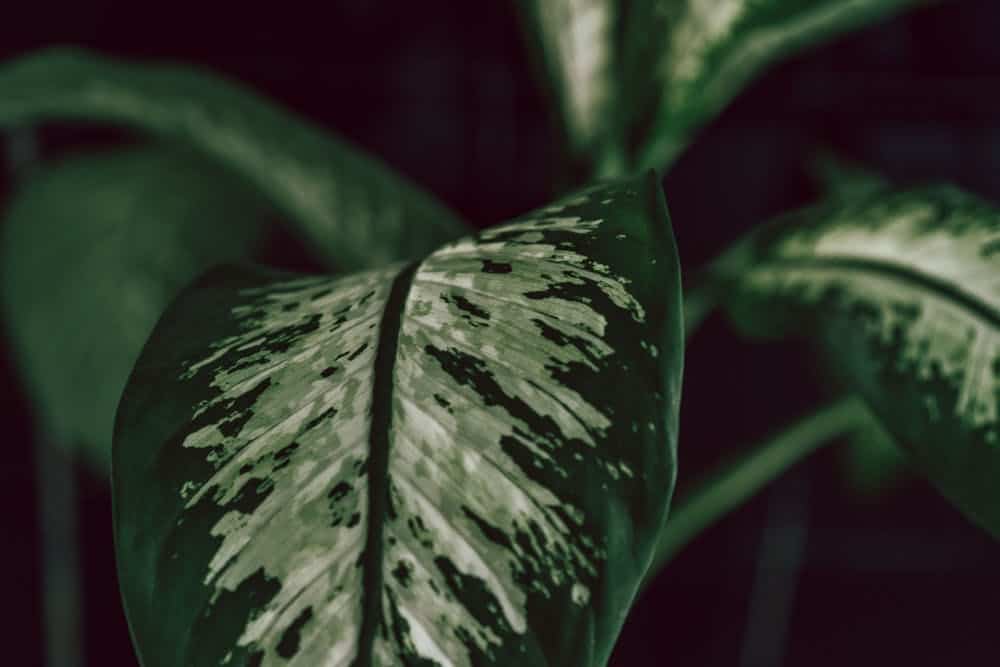Last Updated on January 11, 2023 by a Friendly Gardener
Popularly named “Dumb Cane”, Dieffenbachia is a beautiful addition to any spot. The Dieffenbachia genus belongs to the Araceae family and finds its natural habitat in the Caribbean and South America. This family includes a large number of perennial tropical plants.
Why would such a lovely species be known as “dumb cane”? The name alludes to the fact that if the foliage is chewed, the tongue swells. Hence it becomes difficult to speak and a popular moniker was born.
Everything Diffienbachia

Characterized by large-sized ovate foliage that ends with a point, the individual leave feature mixtures of cream, white, yellow, and green in varied patterns. Large dieffenbachia plants can reach ten feet in height while individual leaves can grow to twenty inches in length. The Dieffenbachiaincludes over thirty species and a hundred cultivars.
Indoor dieffenbachia plants grow roughly three to five feet, and the expansive foliage is known to remove toxins and aid in purifying the air. Dumb cane is a rapid grower. When positioned to receive generous indirect bright light, it can grow as much as two feet a year.
Dieffenbachia Plant Care
The Dieffenbachia is relatively easy to care for when grown indoors, and when cared for it is an impressive plant contributing to the décor of any location. Good light, relatively high humidity, and correct watering are all this plant needs to reward you with a lovely statuesque houseplant.
Soil
Fertile potting soil that drains well is the basis for success. Amending potting soil with high peat content will help. Drainage must be exceptional because soggy soil is the number one cause of damage to the roots. Ideally, the soil bed pH needs to be a bit acidic measuring between 6.1 and 6.5.
Peat decomposes relatively quickly, so repotting may be required at the end of a year. Indications that you need to repot include:
- Compressed soil that is packed around the roots. This impedes oxygen from arriving in the root system and will be lethal if left unattended.
- Lack of drainage. When soil reverts to tiny particles, drainage slows becoming all but impossible. Thisfavorssalt buildup from fertilizers and water, burning roots and damaging the plant.
To mix your soil bed recipe, mix one-part garden soil, one-part peat, one part perlite, and toss in a pinch of lime for good measure.
Light
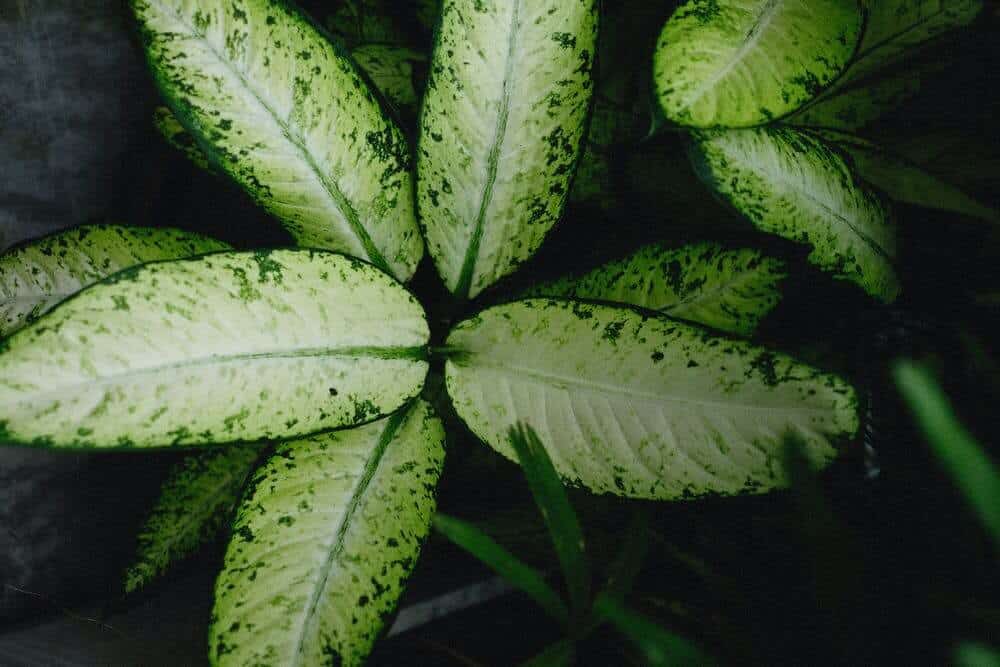
Bright but indirect sunlight is the rule for Dumb Cane when cultivated indoors. They can thrive in partially shady conditions making them ideal as houseplants, but especially in winter, they need lots of indirect bright light exposure. During the growing season, indirect light or some partial shade is fine. Rotate your Dumb Cane weekly, to maintain the plant’s shape.
Water and Humidity
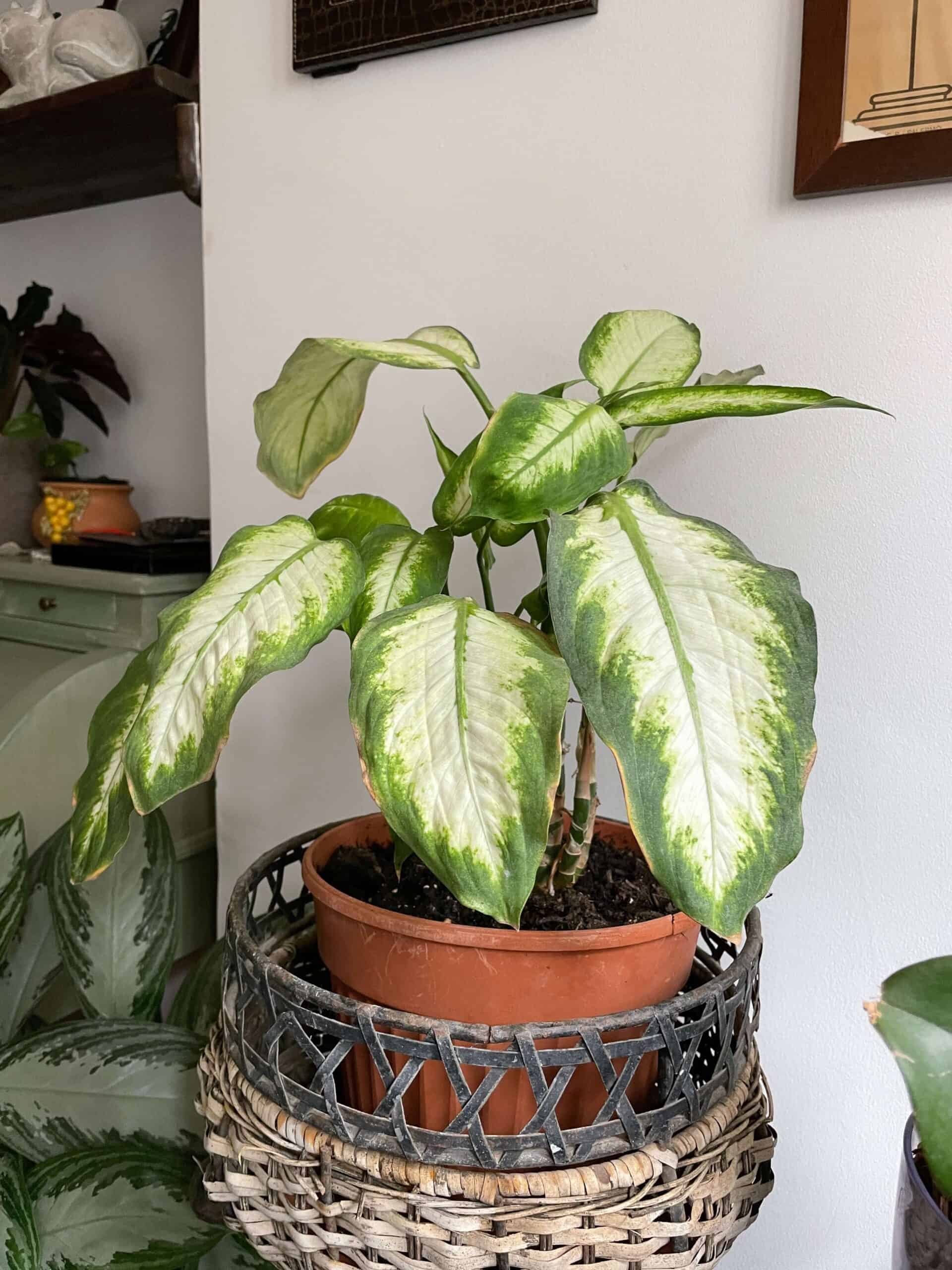
Overwatering is the principal risk for the dieffenbachia. The soil bed’s top two inches need to dry out before the plant is watered again. The drainage of excess water is essential to its survival. Root rot is a common cause of the death of these plants.
Good moisture during the growing season is necessary and your plant may need watering twice weekly. Reduce watering considerably in the winter dormancy months. Allow topsoil to dry out before watering anew.
To prevent salt buildup in the soil bed from fertilizer or municipal tap water, flush out the soil once a month. Place your plant in a sink or move it outdoors and flush the soil out using a hose or faucet. Drain the plant thoroughly before returning it to its location. Terracotta or clay pots are ideal if you fear overwatering as they aid in moisture-wicking.
As a tropical plant, Dieffenbachia prefers high humidity. If the air in your home or office is on the dry side perhaps due to air conditioning or heating, you need to intervene. You can increase humidity around your plant by placing it pebble tray where the stones are consistently wet. You can also mist foliage with a spray bottle although this is a temporary fix. A space humidifier will help, or you can group several plants causing the shared transpiration to increase humidity in the immediate area.
Temperature
This plant originates in the tropics, so it likes warmth. The ideal temperature should measure between 65° and 75° F. If temps drop below 60°F. lower leaves may drop. This will also happen when exposed to cold or cooler drafts.
Fertilization
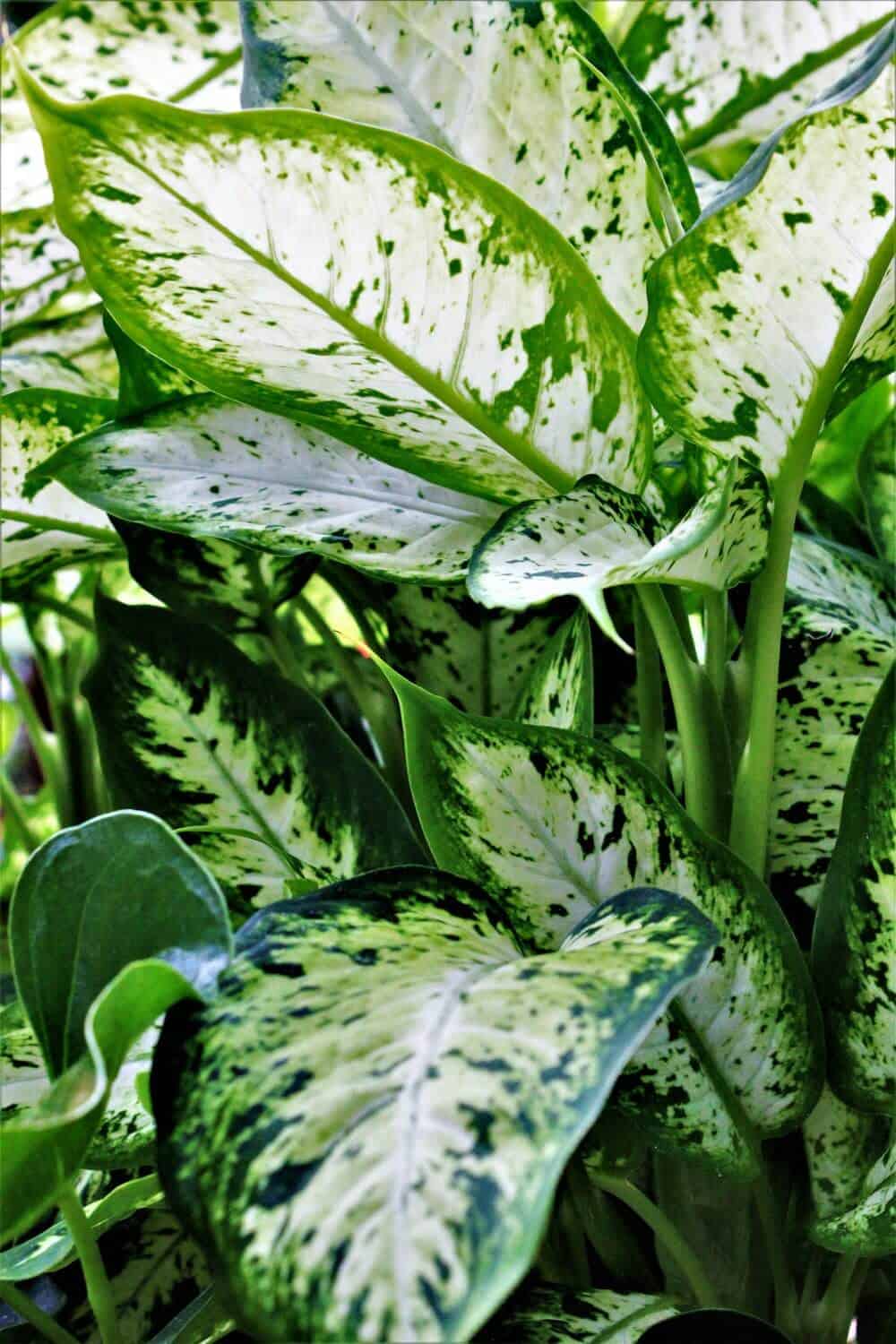
The dieffenbachia enjoys the occasional feed, so every four to six weeks fertilize. Use a quality balanced 20-20-20 NPK water-soluble fertilizer without lime diluted to half strength. Strong fertilizer or over-fertilizing can scorch roots.
Pruning
When lower leaves look under the weather, remove them. These leaves will continue to use energy from the plant, so if they look lackluster, trim them off with sterilized scissors. By removing lower leaves, you can create a nice canopy look that arches downward. Unpruned Dumb Cane resembles a palm tree. Water after pruning.
Should your dieffenbachia appear leggy, pinch new growth from the top regularly. This stimulates bushier growth. If your Dieffenbachia grows too tall, top it by cutting anywhere along the main stem.
Repotting
The Dumb Cane will benefit from an annual repotting as potting soil will have exhausted nutrients. A new pot should be approximately a couple of inches wider and deeper than the Dumb Cane’s root ball and have a sufficient number of drainage holes.
Pests, Diseases, and Problems
Common houseplant pests will torment your Dumb Cane if given the opportunity. Among these watch for
- Spider mites
Leaves turn pale and the underside of the leaves will show a webby substance.
- Mealybugs
Cottony white deposits show up on leaves. Treat the plant with organic neem oil. Pests can be removed manually or washed off with strong water spray.
Overwatering
If you have overwatered, remove the plant’s wet soil. Trim away dead or dying leaves and roots that appear mushy or brown. Leave the plant out to rest bare-rooted for 24 hours. Repot your Dieffenbachia in new potting soil in a properly sized, sterilized pot. Wait a week to ten days before you water.
Symptoms
Yellowing foliagemay be symptomatic of various problems:
- Exposure to cold draft from windows, doorways, or air conditioning units
- Lower growing foliage may have insufficient light
- Overwatering due to an oversized pot, or inadequate draining or drying out.
- Overly dry soil bed
Droopy or wilting foliage points to too little water. Droopy leaves that fall off but remain green indicate your plant is too cold.
Brown leaf tips indicate watering is uneven. Curled, brown-edged leaves can indicate too much fertilization.
Little new growth is generally due to inadequate light, so reevaluate the position of your plant.
Diseases
Diseases that can strike dieffenbachia include:
- Erwinia blight
- Leaf spot
- Petiole rot
- Root rot
- Stem rot
Toxicity and Pets
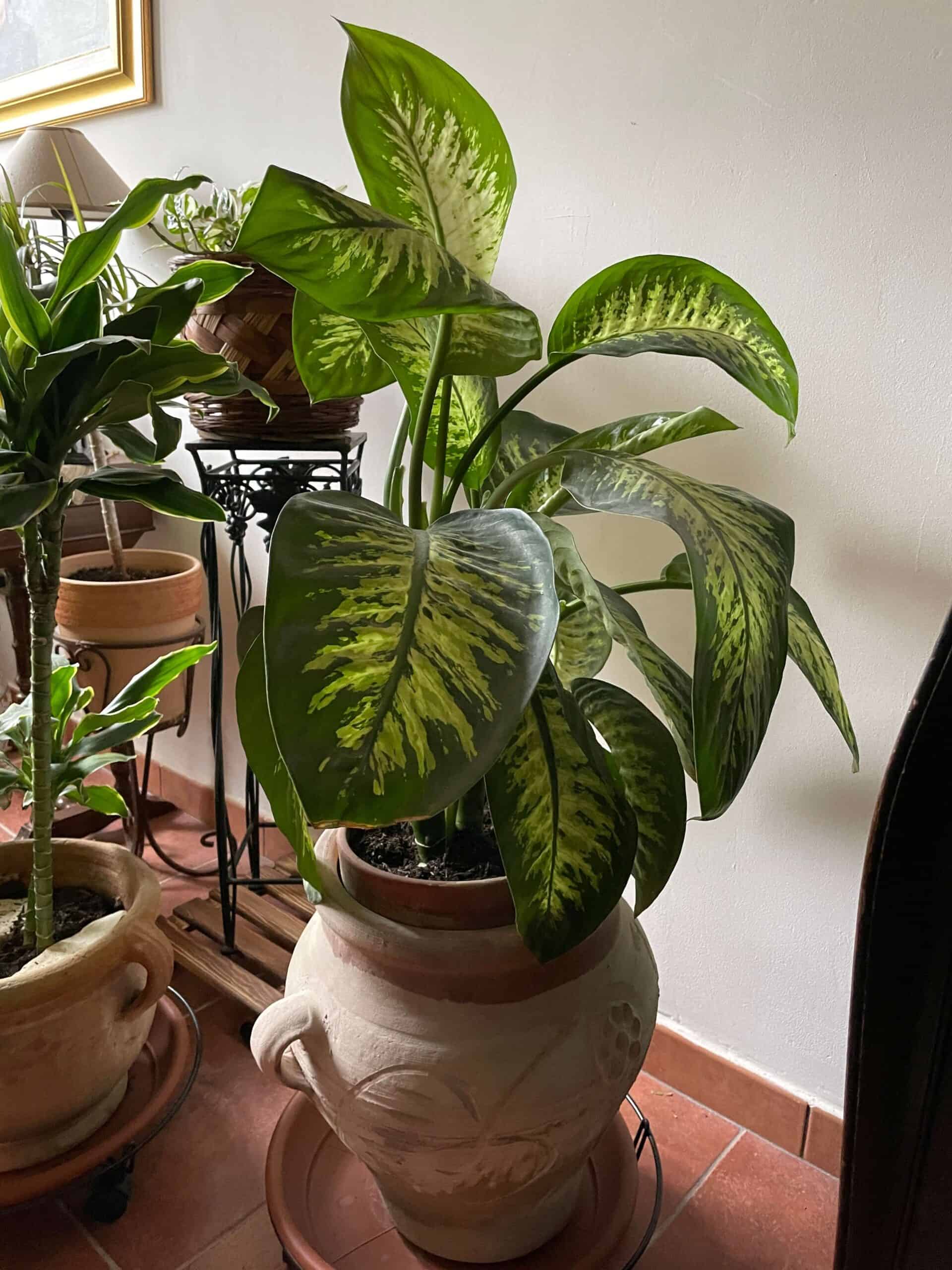
When potting, repotting, or pruning, wear gloves, as the plant’s sap will cause a burning type of irritation to the skin.
Dieffenbachia is moderately toxic because foliage contains calcium oxalate crystals called aphides. These cause swelling and severe burning when the plant is chewed or ingested. Severe symptoms are a sign to get your pet to your veterinarian.
Poisoning Symptoms
Burning and swelling of the tongue, mouth, throat, and even skin are symptomatic of dieffenbachia poisoning an animal may experience difficulty communicating verbally and breathing if the swelling is severe. Left unattended it can cause death.
Generally, pets will stop with the first bite because of the burning. Death is a possibility if leaves are chewed. Rinse the mouth or skin immediately. In the case of swelling, you need a doctor or veterinarian.
Dieffenbachia Propagation
Dieffenbachia can be propagated using one of these methods:
- For mature dieffenbachia plants cut off the top of the plant and move it directly into fresh potting soil after dipping it in rooting hormone. New foliage will sprout from the transplanted top piece. When the new growth appears, Trim away old leaves.
- Lay several pieces of cut dieffenbachia horizontally in a pot with moist potting soil. When these pieces develop roots, new leaves will appear.
- When repotting in the spring, offsets at the base of the plant can be divided as long as they have some roots. Plant these babies in new pots.
Tip: Dieffenbachia does not usually root well when propagated in water.
A Final Word

Dieffenbachia is beautiful and elegant regardless of where it is located. Its cultivation lends itself to gardeners with a little bit of experience with indoor houseplants.

